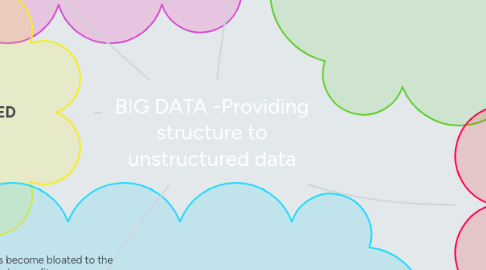
1. APPLICATION
1.1. Big Data VS Cloud Services
1.1.1. Oracle & IBM
1.2. Big Data VS IoT
1.2.1. Smarthome,VYROX
1.3. Big Data VS Data Centre
1.3.1. Digital realty trust,Equinix
1.4. Big Data VS Hadoop
1.4.1. Cloudera,Hortonworks
2. NEEDED
2.1. An entity has collected a lot of data, in the course of its normal activities, and seeks to organize the data so that materials can be retrieved, as needed.
2.2. An entity with skills and vision develops a project wherein large amounts of data are collected and organized to the benefit of themselves and their user-clients.
2.2.1. ex: Google
3. BIG DATA & SMALL DATA
3.1. small data that has become bloated to the point that it can no longer fit on a spreadsheet
3.2. a database that happens to be very large
3.3. False impression from professionals who customarily work with relatively small data
3.3.1. they can apply their spreadsheet and database skills directly to big data resources without mastering new skills and without adjusting to new analytic paradigms
3.4. different : 1-goal 2- location 3-measurement 4-analysis 5-cost 6- data preparation
4. CHARACTERISTIC
4.1. volume
4.1.1. large amount of data,scale of data
4.2. velocity
4.2.1. analysis of streaming data
4.2.1.1. ex:trade data,IoT sensing, network data
4.3. variety
4.3.1. different forms of data
4.3.1.1. ex: traditional db, text image,document
4.4. veracity
4.4.1. uncertainly of data exist, due to the poor data quality
4.4.1.1. ex: One of three business leaders don’t trust the information they use to make decisions
4.5. variability
4.5.1. data whose meaning is constantly change
4.5.1.1. ex: language processing
4.6. visualization
4.6.1. presenting data using graphs and charts
4.7. value
4.7.1. Get business insights
